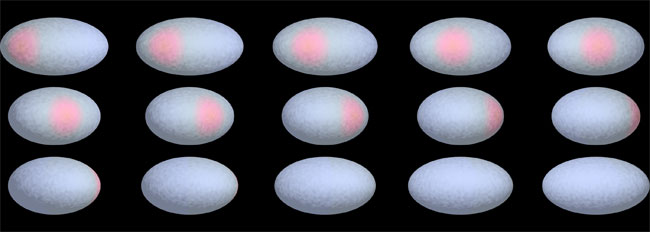Strange Dwarf Planet Has Red Spot

A dwarfplanet in our solar system, called Haumea, is known for its unusual shape andfast spin. Now astronomers have discovered another distinguishing feature: adark red spot which appears to be richer in minerals and organic compounds thanthe surrounding icy surface.
Haumea, discoveredin 2004, orbits the Sun beyond Neptune, in a region known as the KuiperBelt. It is classified as a dwarf planet? a celestial body that is big enough to have been rounded by its own gravity,but has not cleared its neighboring region of similar objects. There are fourother dwarf planets: Ceres, Pluto, Eris andMakemake. Haumea is the fourth largest dwarf planet.
Haumea isalso the fastest spinning large object in the solar system ? one day on Haumeais equal to about 3.9 hours on Earth. This rapid rotation distorts Haumea,elongating it into a football-like shape.
Most ofwhat we know about this object was determined from studying variations in itsbrightness, called a "light curve." And it is through examination ofthis light curve that scientists have found the dark spot.
"Thetwo brightness maxima and the two minima of the light curve are not exactlyequal, as would be expected from a uniform surface," said Pedro Lacerda ofQueen's University Belfast in the United Kingdom. "This indicates thepresence of a dark spot on the otherwise bright surface."
Additionallythe light curve is not exactly the same shape in all wavelengths. Small butpersistent differences indicate that the dark spot is slightly redder invisible light and slightly bluer at infrared wavelengths.
?Our veryfirst measurements of Haumea already told us there was a spot on the surface,but it was only when we got the infrared data that we were able to begin tounderstand what the spot might be,? Lacerda said.
Breaking space news, the latest updates on rocket launches, skywatching events and more!
While theorigin of the spot is unknown, possible interpretations of these measurementsare that the spot is richer in minerals and organic compounds, or that itcontains a higher fraction of crystalline ice. If the spot is a scar of arecent impact, then the spot material might resemble the composition of theimpactor, perhaps mixed with material from the inner layers of Haumea.
Lacerdawill present the discovery Wednesday at the European Planetary Science Congressin Potsdam, Germany.
Newobservations of this spot are planned for early 2010 using the ESOVery Large Telescope. "Now we will get detailed spectroscopy of thespot to hopefully identify its chemical composition and solve the puzzle of itsorigin" Lacerda concluded.

Space.com is the premier source of space exploration, innovation and astronomy news, chronicling (and celebrating) humanity's ongoing expansion across the final frontier. Originally founded in 1999, Space.com is, and always has been, the passion of writers and editors who are space fans and also trained journalists. Our current news team consists of Editor-in-Chief Tariq Malik; Editor Hanneke Weitering, Senior Space Writer Mike Wall; Senior Writer Meghan Bartels; Senior Writer Chelsea Gohd, Senior Writer Tereza Pultarova and Staff Writer Alexander Cox, focusing on e-commerce. Senior Producer Steve Spaleta oversees our space videos, with Diana Whitcroft as our Social Media Editor.
